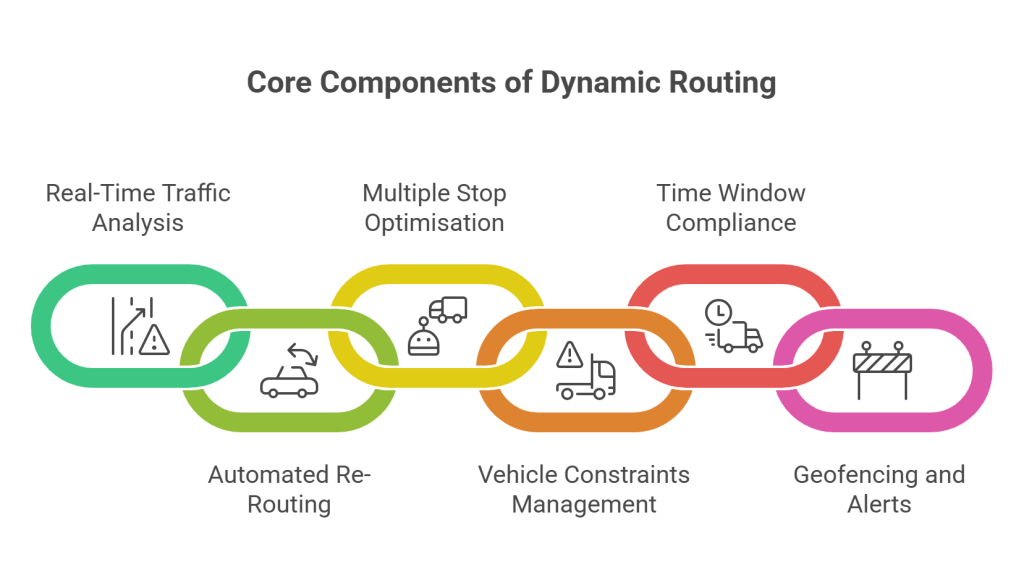In today’s fast-paced logistics landscape, ensuring timely, cost-effective, and efficient deliveries has become a critical business goal. Whether you’re managing a local delivery fleet or a nationwide logistics operation, dynamic route optimisation is emerging as a game-changer. This advanced solution is reshaping how goods move from point A to point B, reducing fuel costs, enhancing customer satisfaction, and minimising delivery delays.

In this comprehensive guide, we’ll break down what route optimisation means, how it works, its benefits, and how businesses can implement it to stay competitive.
What Is Dynamic Route Optimisation?
Dynamic route tracking refers to the process of continuously calculating the most efficient delivery routes based on real-time data. Unlike static route planning, which relies on pre-defined routes, dynamic optimisation takes into account variables like traffic conditions, road closures, delivery time windows, vehicle capacity, weather, and more. The result is a flexible, responsive routing system that adapts to changing conditions instantly.
Why Is Dynamic Route Optimisation Crucial Today?
With rising customer expectations, eCommerce growth, and increasing last-mile delivery costs, logistics operations are under immense pressure. Here’s why dynamic route planning is critical:
- Rising fuel prices demand fuel-efficient delivery operations.
- Real-time customer tracking has become standard, requiring up-to-the-minute delivery adjustments.
- Urban congestion often derails traditional route planning.
- Sustainability targets push companies to reduce CO₂ emissions and environmental impact.
Dynamic route optimisation helps solve all of these challenges by enabling smarter, adaptive routing decisions.
Key Features of a Dynamic Route System

To understand how dynamic route optimization works, let’s look at its core features:
1. Real-Time Traffic Analysis
Integrates live traffic data to bypass congestion and save time.
2. Automated Re-Routing
Dynamic routing software automatically updates delivery routes when a delay or disruption occurs.
3. Multiple Stop Optimisation
Calculates the most efficient sequence of multiple delivery points.
4. Vehicle Constraints Management
Takes into account vehicle capacity, type, and compliance needs.
5. Time Window Compliance
Ensures deliveries are made within committed time slots, improving service quality.
6. Geofencing and Alerts
Enables route monitoring with instant alerts if a driver deviates from a planned route.
How Dynamic Route Optimization Works
Let’s walk through the process:
1. Data Collection
The system gathers inputs such as delivery addresses, customer time windows, vehicle info, traffic, and weather.
2. Algorithmic Planning
AI-powered algorithms analyse the data and calculate optimal routes for each vehicle.
3. Real-Time Monitoring
Routes are adjusted dynamically as new information becomes available.
4. Driver Dispatch
Drivers receive route instructions through GPS-enabled mobile apps.
5. Feedback Loop
Post-delivery data is fed back into the system to improve future routing decisions.
This continuous feedback cycle is what makes route optimisation so powerful.
Benefits of Dynamic Route Tracking

1. Reduced Fuel and Operational Costs
Fuel expenses are one of the biggest costs in logistics. Optimising routes reduces unnecessary mileage and idling time.
2. Improved Delivery Times
Real-time adjustments help maintain delivery schedules even during unforeseen disruptions.
3. Better Customer Experience
Accurate ETAs, on-time delivery, and real-time tracking significantly improve customer satisfaction.
4. Lower Carbon Emissions
Efficient routing reduces the number of vehicles on the road and their emissions, supporting environmental goals.
5. Scalability
Dynamic route planning makes it easier to scale delivery operations without a proportional increase in cost or complexity.
Real-World Examples of Route Optimisation
The importance of route planning in the transport industry will increase in the coming years. Here are a few real-world examples:
1. Amazon Logistics
Amazon uses complex routing algorithms to optimise millions of deliveries daily. Their dynamic route monitoring adapts to order volume, driver location, and traffic in real time.
2. FedEx and UPS
Both companies use advanced route planning systems (like ORION by UPS), which have saved millions of gallons of fuel annually by dynamically planning driver routes.
3. Zomato and Swiggy
Food delivery platforms use route optimisation hacks to assign orders to drivers and optimise their routes for multiple deliveries within specific time slots.
Industries Benefiting from Route Optimisation
While logistics and eCommerce are the primary beneficiaries, many other industries are reaping the rewards:
- Food & Beverage Delivery (freshness and time-critical)
- Pharmaceuticals (temperature-sensitive and regulated)
- Field Services (technicians, installations, repairs)
- Waste Management (municipal route planning)
- Retail Distribution (last-mile delivery to stores/customers)
No matter the industry, any operation involving vehicle fleets and route planning can leverage the advantages of dynamic optimisation.
How to Implement Route Optimisation in Your Business

Implementing route optimization in your business is not just about adopting a new technology—it’s about transforming your delivery operations into a data-driven, agile system. Below are the essential steps to successfully integrate vehicle tracking into your logistics workflow:
1. Assess Your Operational Needs
Before you invest in any solution, you must understand your current logistics ecosystem. Start by asking the following:
- How many deliveries do you make daily or weekly?
- Do you have strict delivery time windows?
- How many vehicles and drivers are in your fleet?
- What are your most common routing challenges (e.g., missed deliveries, delays, fuel waste)?
- Are you currently using any form of routing or fleet management software?
This self-assessment helps pinpoint the scale, complexity, and goals of your dynamic optimisation implementation.
2. Choose the Right Software Solution
Not all route optimisation tools are created equal. Look for fleet management software that specialises in real-time dynamic optimisation and offers features like:
- Live traffic integration
- Multi-stop delivery sequencing
- Time window management
- Driver tracking and mobile app support
- Integration with your existing TMS (Transportation Management System) or OMS (Order Management System)
Popular tools include:
- Locus
- Routific
- OptimoRoute
- Onfleet
- WorkWave Route Manager
If your delivery volumes are high and your operations are complex, look for platforms that offer AI-powered route optimisation, predictive analytics, and automation.
3. Ensure Seamless Integration With Existing Systems
Dynamic route optimisation doesn’t work in isolation—it needs to talk to your other tools. Make sure the software can integrate with:
- Order Management Systems (OMS): For real-time order updates.
- Warehouse Management Systems (WMS): For efficient dispatch planning.
- GPS and telematics devices: For live driver tracking and feedback.
- Customer communication platforms: To send live ETAs and tracking info.
Many route optimization tools offer API-based integrations, allowing for smoother data exchange between systems.
4. Train Dispatchers and Drivers
For dynamic route optimisation to be truly effective, your team must understand and trust the system.
- Dispatchers should be trained on route monitoring, reassigning tasks, and responding to disruptions through the dashboard.
- Drivers must be comfortable using the mobile app or navigation tool, understanding re-routes, and logging delivery status updates.
- Use simulation training and live route scenarios to onboard your team gradually.
- Highlight the benefits: fewer detours, easier navigation, and more predictable workdays.
5. Set KPIs and Monitor Performance
Establish clear Key Performance Indicators (KPIs) to track the success of your dynamic route optimisation rollout. These may include:
- Cost per delivery
- On-time delivery rate
- Distance travelled per route
- Number of failed or late deliveries
- Fuel consumption and idle time
- Customer satisfaction scores
These metrics will help you refine your routing strategies over time and ensure you’re getting a return on your investment.
The Future of Dynamic Route Optimisation
Looking ahead, this technology will only grow more intelligent. Here’s what’s on the horizon:
1. AI & Machine Learning Enhancements
Systems will predict traffic patterns and optimise future deliveries proactively.
2. Autonomous Delivery Integration
As autonomous vehicles scale up, dynamic route optimisation will be critical for their navigation.
3. Sustainability-Driven Routing
Routes may be optimised not just for time, but for minimum carbon footprint.
4. Customer Personalization
Customers may get to choose delivery slots optimised for eco-friendliness or speed.
FAQs – Dynamic Route Optimization
1. What’s the difference between route optimization and dynamic route planning?
Route optimisation is often static and planned ahead of time, whereas dynamic optimisation adjusts in real time using live data like traffic, weather, and delivery delays.
2. How does dynamic route planning reduce costs?
It minimises mileage, idling time, and fuel usage while maximising delivery efficiency and reducing the number of vehicles needed.
3. Can small businesses use dynamic route monitoring systems?
Absolutely. Many SaaS platforms offer scalable solutions tailored to small and mid-sized delivery fleets.
4. What kind of data is needed for dynamic route tracking?
Delivery addresses, driver schedules, traffic conditions, vehicle capacities, time windows, and road restrictions.
5. What is dynamic route tracking?
Yes, it’s especially effective in last-mile delivery where real-time adaptability is critical due to changing customer needs and traffic conditions.
Conclusion
In a delivery economy driven by speed, reliability, and cost-efficiency, dynamic route optimization is no longer optional—it’s essential. It empowers businesses to make data-driven decisions, reduce operational burdens, and meet growing consumer expectations. For further assistance in optimization and traceability planning, contact Qodenext today.







